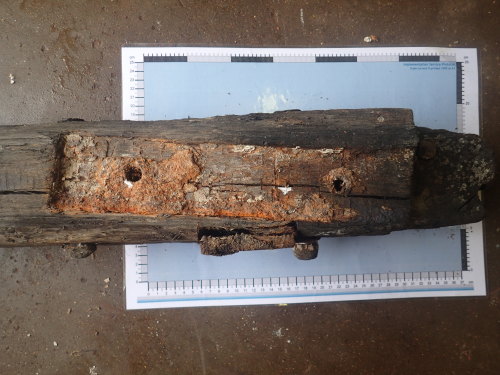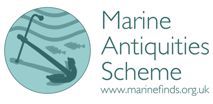
Image use policy
Our images can be used under a CC BY attribution licence (unless stated otherwise).
TRANSPORT
Unique ID: MAS-F100107
Object type certainty: Probably
Workflow
status: Published ![]()
This ship's timber is 830 mm long, 110 x 120 mm in profile, with truncated 25 mm diameter treenails; and a 385 x 65 mm slot for the supporting metal work from which the visible corrosion products suggest that they were of iron construction. The images were forwarded to ship expert and author Richard Endsor.
The timber appears to be the beam end from a small ship, with evidence of knees on both sides. The small piece of plank let into it crossways may be the remains of a waterway at the side making this face the upper side of the beam. The treenails probably secured the plank. The notch at the beam end may have fitted between the frame timbers of the ship's hull. The recessed slot may be to take a lodging fore and aft knee, and the flat section on the opposite side would be for a hanging knee.
The evidence of corrosion products on the beam suggest that it is from a modern ship, as although iron support structures in the construction of ships appeared during the latter part of the18th century, they were only initially used in warships and large merchantmen, and not until later in smaller vessels such as fishing boats and sailing barges. The retrofitting of them in warships was common during the Napoleonic wars. The uptake of iron fitting was very much linked to the availability of wood, and therefore most ships were built of wood with wooden framing components and some iron strengthening, the Cutty Sark, built in 1869, is one example of this approach. The different designs of iron knee, where they survive, also act as a useful guide to dating wreck sites, particularly in the case of British wrecks. European and American built wrecks, where good quality timber was readily available or cheaper means these are less easily dated by their metal components.
Class:
SHIP
Sub class: Timber
Subsequent actions
Current location of find: With finder
Subsequent action after recording: Submitted as wreck to the Receiver of Wreck
Wreck details
Droit number: 224/17
Chronology
Broad period: POST MEDIEVAL
Period from: POST MEDIEVAL
Period to: MODERN
Dimensions and weight
Quantity: 1
Length: 830 mm
Width: 120 mm
Thickness: 110 mm
Discovery dates
Date(s) of discovery: Wednesday 23rd August 2017
Personal details
Found by: This information is restricted for your login.
Recorded by: A BB
Other reference numbers
Droit ID: 224/17
Materials and construction
Spatial coordinates
4 Figure: TQ4400
Four figure Latitude: 50.78170298
Four figure longitude: 0.04126088
1:25K map: TQ4400
1:10K map: TQ40SW
Display four figure position on What3Words
Unmasked grid reference accurate to a 1 metre square.
References cited
No references cited so far.
Similar objects

Find number: MAS-F100111
Object type: AIRCRAFT COMPONENT
Broadperiod: MODERN
Aluminium aircraft section, heavily corroded and damaged. No identifying marks or plates visible, though two cross member plate remnants prese…
Workflow: Published![]()

Find number: MAS-O100026
Object type: SHIPS TIMBER
Broadperiod: NINETEENTH CENTURY
Two fragments of waterlogged wood with two copper fasteners dating from the post-medieval period onwards.
The wood may be the remains of two …
Workflow: Published![]()











